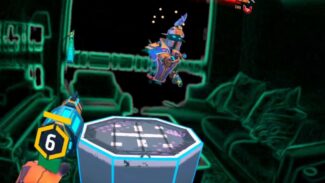Using Quest’s passthrough feature with Resolution Games’ Blaston results in a pretty incredible experience.
Meta recently made the Passthrough API for Quest 2 available for everyone, moving away from an experimental build to a full release. Blaston is one of the first games to take full advantage of the technology and, in doing so, almost completely revolutionizes the game.
Blaston Passthrough Gameplay
In July, Meta added the experimental Passthrough API for developers to play around with, which we saw in action in a few titles like Cubism. However, more recently the API graduated from experimental to full release, allowing Oculus Store apps to add support whenever and however they pleased.
Just last week, Resolution Games updated Blaston, giving players the option to turn on a stylized version of passthrough as your play environment. Everything around you is bathed in a neon-like outline, with the podiums, scoreboard and opponent fixed on top of the overlay in an AR-like fashion. Of course, this isn’t ‘true’ AR — it’s a display showing a video feed, not a transparent display, and there’s certainly no occlusion or depth mapping either. However, for the Quest 2 it’s pretty cool.
At first, I was skeptical — it’s a feature that I was worried might look fun but feel somewhat redundant at launch. However, for games like Blaston, it comes close to completely revolutionizing the game in a way I didn’t think possible. By letting you play in a reconstructed version of your surroundings, Blaston has completely eliminated concerns about your guardian or nearby objects. In turn, this creates a way more freeing, natural experience and, more importantly, it actually makes the game much more enjoyable to play.
I tried Blaston around release and my biggest problem was that I couldn’t really properly immerse myself. It’s a game that requires lots of quick movement and dodging and, ideally, a pretty large play area. I have a small area in my lounge room that’s suitable for most VR experiences — there’s stuff around me, but I have a nice (if small) square of empty space to place a guardian down and move around in.
However, for games like Blaston, it still feels cramped. The reality was that I had plenty of room to play, but I still felt squashed and constantly worried I would get to into it and accidentally send my hand into a wall or worse… my nearby TV.
Playing Blaston in passthrough mode, these problems were completely eliminated. I could play stress free, knowing exactly where everything was and without worry of any accidents. Yes, this is solving a problem that some people won’t have — if you have a giant house with lots of empty, spare space, this would never have been a problem for you. However, the reality is that most people won’t have a huge amount real estate for VR, especially people who only play casually. For those players, passthrough mode makes Blaston feel integrated into your space, instead of taking you out of it, and that’s absolutely crucial. I’m playing in the same space, but it feels like I now have so much more.
Blaston is not the only game to add support (and it certainly won’t be the last) — one of my Quest 2 favorites, Unplugged, also recently added “Your Place” as a venue option. This lets you shred air guitar in a environment that is basically just a variation on the black and white Quest 2 passthrough video feed, overlaid with big colour tones that match the gig, music and game’s lighting. It’s a great option, but it doesn’t solve a problem in the same way that Blaston does. It will surely be useful, if not fantastic, to use when playing Unplugged with a group of people, but that’s not exactly improving anything about the way you play the game. It’s just adding a niche cool feature.
With Blaston, playing in my living room actually let me enjoy the game in a way I couldn’t before. It’s also opened my eyes to the possibilities of the technology, not just on Quest but in the future as well, as we move towards the larger promise of true AR headsets.
Passthrough support is available in Blaston now for Quest 2 users. You can read more here.





